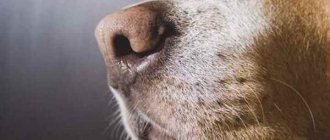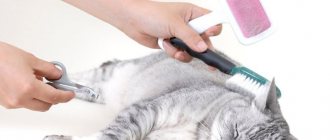Causes of ear problems in dogs
Periodic head shaking is normal for a dog, but if this behavior becomes regular, then you should start sounding the alarm. At this time, the animal becomes restless and whines. All this may indicate the presence of various ear infections.
The dog shakes its head - there are problems with the ears
Ear otitis
This inflammation mainly occurs in dogs with long ears or those that have large folds of skin, such as bulldogs. It is because of the presence of folds that the ear canal is blocked and air does not circulate in that place, resulting in the accumulation of lubricant. If a bacteria gets into it, an inflammatory process immediately begins to develop.
Note! The presence of purulent plaque, swelling of the ears and the appearance of an unpleasant odor are evidence that the disease has become advanced. The animal may stop eating and become weaker just before our eyes.
Foreign body
If your dog shakes its head frequently, the reason may lie in the presence of a foreign body. Upon examination, the owner may find a bead, a twig or some other small things that can get into the ear canal during a walk or active play with a pet. You can try to get the object out yourself, but you need to be careful not to push it further and thereby aggravate the situation. It is best to immediately seek help from a veterinarian.
Damage or blockage of the ear
You can get damage to the eardrum when cleaning your ears with a cotton swab, loud noise, or pressure changes, for example, during takeoff or landing. But the blockage is formed due to the formation of wax plug, as a result of which the dog begins to shake its head.
Otodectosis, ear mites
A disease called otodectosis is caused by small mites. During their penetration, damage occurs to the auricle, ear canal and eardrum. When a parasite bites, the toxic substance contained in its saliva enters the bloodstream, causing severe infection. You won’t be able to detect it yourself, only in laboratory conditions.
Examining the animal for ear infections or foreign bodies
Ear vasculitis
This disease affects the tips of the ears, because this is where a large number of blood vessels are located. The disease can appear due to allergies, kidney disease, diabetes, or due to neoplasms.
Note! Ulcers can form on the inside of the ear, which will gradually increase in size if medical care is not provided.
Allergic manifestations
A fairly common problem in dogs. Symptoms such as redness, swelling, and itching can be observed. If a dog begins to constantly itch, an infection often occurs, resulting in purulent discharge, a bad odor, and the skin begins to peel off.
If exposed to water
If water gets into a dog's ear, the animal will also constantly move its head, trying to get it out. In this case, you can help him by using ordinary cotton wool. Dogs with small ears, such as Spitz, can suffer from this problem, but representatives with long ears do not face this problem.
Chlamydia
At first, the disease in animals can be completely asymptomatic, but when it enters the second stage, the dog experiences arrhythmia, complete refusal to eat, purulent discharge from the ears, nose and eyes, and elevated body temperature.
The main symptom of chlamydia
Eczema of the ear
The cause of the development of the disease may be the presence of eczema in other parts of the body, a foreign body entering the ear canal, mites, or damage from chemicals. The main symptoms of the disease are redness, swelling, and severe itching. In this case, the animal constantly shakes its ears and holds its head to one side.
Dog ear infections
To avoid the occurrence of various ear infections, it is worth monitoring the hygiene of the animal. Regularly clean your ears of dirt with a regular swab or while bathing.
Important! It is worth showing the animal to the doctor if it constantly shakes its head and at the same time whines and does not allow you to touch its ear.
Causes
There can be many reasons why a dog scratches its ears, so additional symptoms will be different in each case:
- An ear mite
is a parasitic microscopic insect that enters the ear canal and, as a result of its vital activity, causes irritation of the mucous and serous membranes of the ears, which leads to discomfort for the pet. Another pet, especially a cat, can act as a source of infection. As a rule, the mite infects both ears, as a result of which the skin there acquires a bright red (sometimes even purple) color, a brown coating, crusts and sometimes a characteristic putrid odor are formed. The dog not only scratches its ears, but also whines, especially if you touch them. Treatment is prescribed only based on the results of scraping, since the tick itself cannot be seen with the naked eye, but with the help of a magnifying glass you can see small moving white dots. - Allergic reaction
- occurs due to hypersensitivity or intolerance to any drug, food, plant or other possible allergen. It is accompanied by severe itching and the appearance of wounds, which the dog scratches until it bleeds. But the first sign is redness and swelling of the ears.
- Water ingress.
This can happen while swimming at home, swimming in ponds, or walking in the rain. In this case, the ingress of clean water usually does not cause problems, but if water enters from a stagnant body of water, sea or ocean, or mixed with detergents, this is often fraught with unpleasant consequences.
- Entry of a foreign body.
After an active walk, plant seeds, grass stems, branches or other objects may get into your ears. If they are not removed promptly, they will cause irritation, causing the dog to scratch his ear and shake his head. - Otitis (external, middle or internal)
is an inflammation that is characterized by pain, so the pet whines and does not allow the sore spot to be examined. It can be caused by the action of bacteria and fungi, hypothermia, weakened immunity and other factors. In addition to constant shaking of the head, the disease is accompanied by the appearance of discharge (from clear to bloody and purulent) and an unpleasant odor from the ears. The dog develops apathy, appetite worsens, in the first stages of the disease the ears become much hotter, and over time the general body temperature rises. Also, otitis may be indicated by a constant tilt of the head to one side: this reduces the pressure in the auricle and dulls the pain.
It is worth noting that certain breeds have a predisposition to this type of disease. This applies to dogs:
- with drooping ears or many folds on the head, including in the area of the ears (cocker spaniel, dachshund, retriever, sharpei, etc.), as a result of which this space is insufficiently ventilated, which creates a favorable environment for the development of bacteria and microorganisms;
- with ears overgrown with hair, which can retain sulfur secretions and, as a result, cause inflammatory processes (poodle, Yorkshire terrier);
- intended for hunting (in the process they often run into the water, which ends up in the ears).
Note: pets who like to ride in cars with their heads hanging out of the window can also develop inflammatory processes in the ears.
Symptoms of probable diseases
The dog scratches its ear and shakes its head: why and what to do
The main thing to remember is that if an animal shakes its head, it means something is bothering it and in most cases this is associated with hearing problems. The following negative symptoms are identified, in the presence of which it is necessary to start sounding the alarm:
- the appearance of an unpleasant odor from the ears;
- the animal tries to scratch its ear in every possible way;
- the presence of red-brown discharge from the auricle;
- increased body temperature, the dog begins to tremble;
- deterioration of health;
- swelling;
- squelching sounds are heard from the ear;
- The inside of the ear becomes reddish and moist.
Symptoms of ear disease
If your animal frequently shakes its ears, the first thing to do is to carefully examine the inside of the ear. A healthy ear shell will be clean and pale pink in color. When there is a rusty or brown coating in the middle, purulent discharge, swelling - an inflammatory process on the face.
If the disease has been progressing for a long time, then the examination will be more complicated. Because of the pain, the pet will shake its head and constantly scratch its ear, preventing it from looking into it. The animal may tilt its head towards the affected ear. Visible signs of the disease may not appear, then you need to sniff the diseased organ. In case of inflammation, an unpleasant odor will be heard.
You need to fix the dog’s head if you need to turn to loved ones for help. After this, lightly press on the base of the ear from the back of the head. That is, in the place where the ear begins to “grow”. If the dog reacts, this is the first symptom of otitis media (inflammation of the middle ear).
If the disease is not detected in time, neglected, or not treated at all, the pet will suffer serious complications, go deaf, or even die. Therefore, such a problem must be treated with full responsibility.
What to do if your pet is picking at its ears
The cat shakes his head and scratches his ears, but they are clean
If your pet has the following negative symptoms, it should be taken to a veterinary clinic immediately:
- complete refusal to eat;
- lethargy;
- increased body temperature;
- purulent discharge from the ears;
- impaired coordination of movements;
Note! If you notice that your dog is shaking its ears, then a visit to the veterinarian cannot be postponed until later. If treatment is not started on time, irreversible consequences may occur.
Aggressive behavior of an animal during the presence of an infectious disease
Why is delay dangerous?
If you suspect that your four-legged friend has an ear disease, then you should not postpone a visit to the veterinarian, otherwise there may be unpleasant consequences. Ear diseases have pronounced dynamics and progress quickly, which means that the dog will get worse and worse. The animal will begin to get irritated and behave aggressively.
We recommend this article:
Basic symptoms and rules for treating scabies in dogs
For various inflammatory and infectious diseases, if treatment is not started in time, the eardrum may collapse, and inflammatory processes will affect the brain. In any case, you should not self-medicate.
It is very dangerous if sea water gets into the ear. Salt water will burn delicate skin. In addition, microorganisms and mollusks can get into the auricle and live there for years, causing discomfort.
Recommended Posts
Why does a dog whine and tremble, as if with a chill?
How and what to clean your dog's ears at home
Why does a dog growl at its owner and what to do about it?
Standard and docking of ears and tail in the Cane Corso breed
Why is your dog constantly licking and swallowing saliva?
Why does a dog have bloody diarrhea and what to do?
Consequences of late contact with the veterinarian
Ear diseases in rabbits: head shaking and ear scratching
The presence of any infection or ear disease progresses very quickly, so the animal’s condition will immediately worsen, pain and discomfort will appear. In advanced situations, treating a pet will cost several times more than in the initial stages.
In addition, if there are any problems, the dog becomes aggressive and can behave completely unpredictably, which is dangerous if there are small children in the family. In some cases, progression of the disease can lead to the death of the animal.
Prevention measures
To prevent your pet's ears from getting sick, you should take proper and careful care of them. To do this, you need to trim the fur in them as it grows.
As a preventative measure, it is necessary to closely monitor the behavior of your pet and do not forget to regularly, at least once every 3-4 weeks, clean your pet’s ears with a cotton swab or cotton swab soaked in hydrogen peroxide.
It is also advisable to use medications that protect the dog from ticks and other pests. These can be ordinary anti-tick drops that should be applied to the animal’s withers. Medicines are applied 2-3 times, after which the animal is protected from insects for a period of up to 3 months.
Reference! Many veterinarians strongly recommend cleaning the animal’s ears in a specialized clinic, since cases of hearing loss in dogs due to careless ear cleaning have increased significantly.
Cleaning
Having figured out the reason why the animal scratches its ears and shakes its head and, having eliminated it, you should control the pet for some time during walks and prevent it from contacting stray animals. Also, you should not allow your dog to come close to garbage containers, as harmful parasites or viruses may live there. You need to keep your pet clean and when bathing, try to prevent water from getting into the ears.
Prevention of ear diseases
It became clear why the dog’s head is shaking, but now it’s worth talking about what needs to be done to avoid the problem. To do this, you need to follow a few simple rules:
- Inspect the dog’s ears daily for wax, redness, unpleasant odor, and discharge;
- If water gets into the animal’s ear while bathing, it must be removed immediately with a cotton pad;
- Regularly clean your ears of dirt after walking outside;
- avoid hypothermia;
- since stray cats and dogs are often carriers of various infections, contact with them should be avoided;
- carry out anti-parasitic treatment of the ears at regular intervals.
Thus, if at least one negative symptom appears, you should not self-medicate, but it is better to immediately seek qualified help from a specialist in order to avoid complications and protect the animal from death.
Ear mites or otodectosis
When a dog frequently shakes its ears, with light pressure at the base of the auricle, it does not give a reaction - the cause may be a mite inside the ear. A dog can pick up a parasite not only while walking outside. A tick will easily enter a home on a person’s shoes or on a cat’s fur.
When examining the auricle, you can see a red surface, in some places even small bloody spots. The parasite itself is almost invisible, but because it causes constant itching, the dog scratches itself into blood.
If the dog does not allow himself to be examined, you need to take a cotton swab, soak it in warm water and very carefully roll it in the middle of the ear. The result will be obvious if a tick lives there.
By sniffing the stick you can determine how long the disease has been progressing. The absence of any odor indicates that the tick is parasitic alone, and the ear is not additionally infected with fungus or infection. If there is an unpleasant odor, then there is no way to avoid using antibiotics.
For otodoctosis, use “Amidel gel” or “Mr. Bruno plus”. In the case of antibiotic use, Ivermek spray is most often prescribed. It is worth knowing that this product is quite toxic and is highly not recommended for use indoors. Treatment should be carried out once a week and it is better to do it outside.
When your pet has severe itching, it needs to be soothed. “Amit” is considered the best drug. It contains antipruritic components, an antibiotic and an acaricide.
Symptoms
Inflammation of the outer ear is observed more often than medial and internal otitis. Unilateral pathology is recorded less frequently than bilateral pathology. Symptoms of inflammation include the following:
- The dog's behavior changes. She becomes lethargic or anxious.
- Head shaking accompanied by furious scratching is observed.
- The dog refuses kibble food.
- The inside of the shell becomes hyperemic and becomes covered with a brownish-red coating.
- A purulent or dry, unpleasant-smelling mass emerges from the ear canal.
- The dog whines, runs in a spiral, constantly reducing the radius.
- The animal does not allow you to touch its ear and tries to bite.
- General and local hyperthermia develops.
- Coordination of movements is impaired.
In advanced cases, deep scratches are recorded, the shell is deformed, and the dog tears it to shreds. Wounds and ulcers occur. The tissues covering the auditory canal thicken, scar, and block the passage. In addition to deafness, the outflow of exudate stops, and there is a danger of meningitis.
Tremor as a symptom of an acute reaction requiring emergency care
Painful sensations also cause trembling in older dogs. As prescribed by the veterinarian, the dog is given pain medication, after which the causes of the disease are identified. If a dog is in pain, most often it does not eat anything, is depressed, prefers to remain quiet, and squints or defends itself when the painful area is probed.
The reasons why a dog may tremble are physiological and pathological. The first include harmless conditions that arise under the influence of external factors and require minimal human intervention.
What to do at home?
Try to find out the cause of the shaking ears. Secure your pet, carefully hold the head so as not to damage the dog’s neck, especially for miniature breeds.
Look into the ear canal to see if there is any redness, discharge, foreign bodies, or if there is an unpleasant odor. Normally, a specific aroma may be present; some owners describe it as the smell of dried mushrooms.
If you find an insect in your ear, you can pour ear lotion into the ear canal to remove it.
If there is a large amount of discharge, then you can also fill the ears with lotion, for example, Otifri , and clean it with a cotton pad.
It is better to put a protective collar on the dog so that it does not injure the auricle with its paws or on surrounding objects, as otohematoma may occur - a rather unpleasant problem for both the animal and its owner.
Try to go to the clinic as soon as possible for research: otoscopy, ear scrapings, cytology of the contents of the ear canals.
Izotik ear drops . They have a pronounced anti-inflammatory effect, activity against fungi and bacteria.
However, this is not a panacea; the drugs may not help if the cause of otitis is, for example, an excessive amount of hair, a foreign body or an allergic reaction.
Watch the video: The vet clearly shows how to treat a dog’s ears
Seizures in dogs: causes and treatment
The most common cause of involuntary muscle contractions is epilepsy
.
Epilepsy is of two types: primary
and
secondary
.
Primary
caused by genetic disorders in the functioning of the brain and nervous system. It can appear in dogs aged from six months to 5 years.
Secondary
arises due to a variety of unforeseen situations, including the following:
Important!
These disorders in the animal’s body provoke not only the development of epilepsy and, as a consequence, epileptic seizures, but also the appearance of other types of seizures: convulsions, clonic and tonic seizures in dogs.
So, how can you tell if it’s an epileptic seizure? First of all, remember your pet’s behavior before the seizure.
At the first stage
The pet’s desire to hide from strangers manifests itself, it shakes and whines, and appears in an anxious state.
Then the second stage
- at a certain moment the dog loses consciousness, falls, has convulsions all over its body, it breathes heavily and shakes, all this is accompanied by the release of foam from the mouth.
After this comes the third stage
- postictal stage, when the animal begins to slowly come to its senses, it is not oriented in space and is somewhat alarmed. Usually the seizure does not last very long, about 5 minutes.
But sometimes it can be very long - about half an hour. This usually occurs when the body is in a neglected state.
What to do when your pet has a seizure? It is best to immediately contact a veterinary clinic or call a veterinarian at home. While the seizure lasts, you need to isolate the animal from sharp corners and hard objects so that it does not get injured.
Never try to put anything in the mouth
, this can end tragically both for your pet and for you, because a cramped jaw is very difficult to unclench. Transportation to the hospital is best carried out in a soft blanket. Your main task is to ensure that the pet does not harm itself. Be sure to take care of the muzzle and...
Important!
It is a popular belief among veterinarians that touching an animal during a seizure in any way can only make the situation worse. Therefore, it is better to rid your pet of any external stimuli: loud sounds, bright flashes, sharp touches.
The causes of uncontrolled muscle contractions may vary between breeds. For example, seizures in small breed dogs are often caused by hypoglycemia
- reduced amount of glucose in the blood.
In large breeds, the most common cause is epilepsy
.
Why is my dog's head shaking?
It happens that a dog experiences convulsions only in a specific part of the body (most often the head and lower jaw shake, and convulsions of the hind legs also occur), then the option with epilepsy is definitely not suitable. Most often, such local muscle contractions are caused by:
- disruptions in the functioning of the nervous system;
- infectious diseases;
- nervous overstrain;
- strong negative emotions.
At the first appearance of such “shaking”, you should immediately contact a veterinarian
, then there is a chance to avoid unpleasant consequences.
Cramps in sleep
Most often, puppies and easily excitable dogs twitch in their sleep. They seem to be having “bad” dreams, but in reality they are anxious and afraid. If you see that your pet is shaking in its sleep, then gently, gently touch it and stroke it, cover it with a warm blanket.
This is quite enough for your pet to calm down and sleep more soundly. If convulsions occur not only during sleep, they are not easy to calm, then it is necessary to conduct a full examination in the clinic
to find out the reasons.
Important!
Animals also have “nervous breakdowns”, they can be accompanied by convulsions. To make the animal feel better, you just need to spend more time with it and isolate it from any unpleasant environmental influences.











